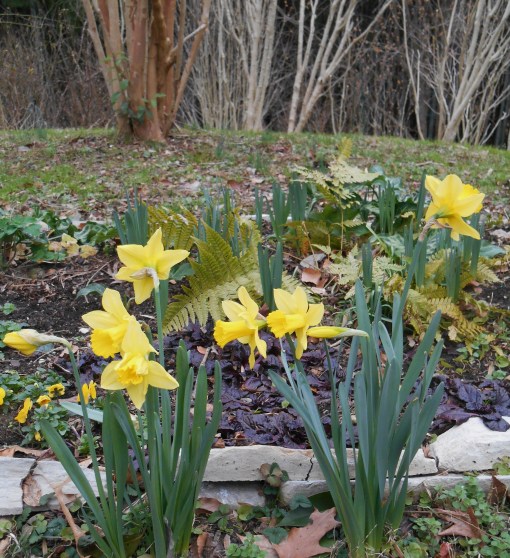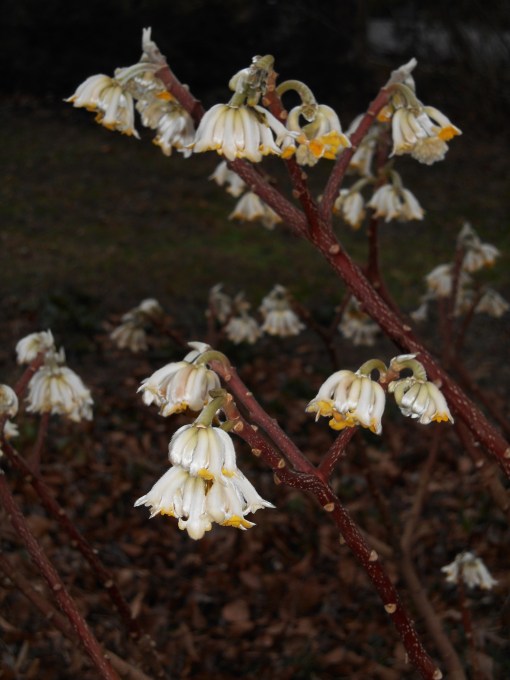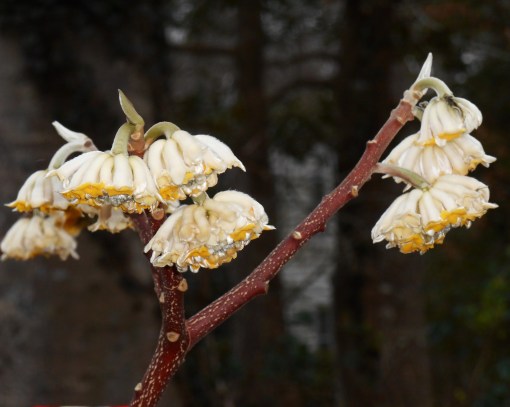
~
Unusual leaves bring great energy and interest to our garden. Caladiums, like this C. ‘Gingerland’ offer a long lasting, bold accent in sun to partial shade. Each leaf is unique, painted in clear bright color across its graceful, undulating form.
~

~
A pot filled with Caladiums can be stunning. But mix Caladiums with ferns, vines or annuals for uniquely interesting arrangements. ‘Gingerland’ was our first Caladium in leaf this year from the new batch ordered in April.
~

~
Caladiums also mix well with other Aroids, like Alocasia ‘Stingray.’ Their cultural needs are similar. These C. ‘Sweet Carolina’ overwintered together with the Alocasia in their pot in our garage. Heavy feeders, the more generous you can be with water and fertilizer, the larger and more lush they will grow.
~

~
Newer Caladium varieties can take more sun than you might imagine. I had this pot of C. ‘Moonlight’ and C. ‘Desert Sunset’ in partial sun until our recent spell of hot, dry weather. It is photographed here in deep shade, a temporary resting spot until the weather moderates.
We enjoy the beacon like effect of these luminous white leaves shining from a shady spot in the garden.
~

Alocasia ‘Frydek’
~
Alocasia have just appeared on the market in recent years. This unusual tropical plant also grows from a tuber. One of the first commonly available was Alocasia micholitziana. A widely marketed cultivar is known as A. ‘Frydek’ or ‘African Mask’ or Alocasia Polly.
These ‘elephant ears’ are often sold as house plants, and do well in normal indoor conditions year round. Sometimes they will go dormant and appear to die back. Just be patient and keep the soil a little moist. You will usually be rewarded with new leaves in a few weeks.
~

~
Alocasia are long-lived plants, which grow larger each season. They enjoy a partially sunny spot in our summer garden. Their deep green, substantial leaves last for months at a time. Bring them indoors in winter, if only to a garage or basement, and you will be rewarded with additional years of beauty.
There are many new types of Alocasia on the market these days. In addition to A. ‘Frydek’ and A. ‘Stingray,’ we also grow A. ‘Plumbea’ and A. ‘Sarian.’
I recognized some plants at our local Trader Joe’s as unnamed Alocasia back in February, and bought two. We kept them going in the dining room until it warmed enough to move them outdoors this spring. they have put out prodigious growth and their leaves are now about 18″ long, each.
~

Begonia Rex with fern
~
Another genus with unusual and beautiful leaves, Begonia, also thrives in our summer garden. Tropical, most varieties of Begonia enjoy heat and humidity. Although they often pump out delicate flowers all summer long, we growth them mostly for their outrageous leaves.
~

Cane Begonia
~
Although not as large as Caladium or Alocasia leaves, some Begonia varieties have large, extravagantly marked and highly textured leaves. B. ‘Gryphon’ appeared in local shops perhaps six years ago. It will grow quite large by the end of summer, and the plants keep well from year to year.
~

A newly unfolding leaf on B. Gryphon. The red fades to a more even green as each leaf matures, though the stems remain red.
~
B. ‘Gryphon’ can be propagated from stem or leaf petiole cuttings. Simply stick a section of the trunk into a pot of moist soil, and wait. I generally use a little rooting hormone on the cut end of the stem. The stem will root in moist soil, with new growth appearing in just a few weeks in summer. I overwintered a stem cutting in our garage last winter, and new growth appeared a few weeks after we put it outside this spring.
B. ‘Gryphon’ is grown for its beautiful leaves and tropical form. It will eventually produce some small flowers in its second or third year.
~

~
Begonia Rex come in hundreds of varieties. Their leaves are beautifully patterned. I’m seeing these offered at big box stores in spring along with annuals and other shade perennials. Although perennial, they are tender and won’t survive freezing temperatures outdoors. I normally grow these in pots to keep from year to year.
They grow from rhizomes, and may appear to ‘die’ at times. Often, the plant has gone dormant due to stress, and will begin to produce leaves again if given minimal care and warmth.
~

~
Begonias can be heavy feeders. They like their soil to dry out a little before you water again, and thrive in bright shade. They enjoy the humidity when placed under trees in our summer garden.
~

Begonia
~
Unusual and colorful leaves keep a garden fresh and fun. Ours have the garden looking Fabulous this Friday!
Whether you have one wonderful pot of Caladiums, or a garden filled with striking foliage, you will soon be hooked.
When you realize how easy and resilient these plants can be for you to grow, and how long-lived and tough these tropical beauties become; you may soon will find yourself collecting them, too.
~

Alocasia ‘Plumbea’
~
Woodland Gnome 2017
~
For the Daily Post’s
Weekly Photo Challenge: Unusual
~

~
Fabulous Friday: Happiness is contagious, Let’s infect one another!
































 ~
~





 ~
~











































 ~
~

 ~
~
